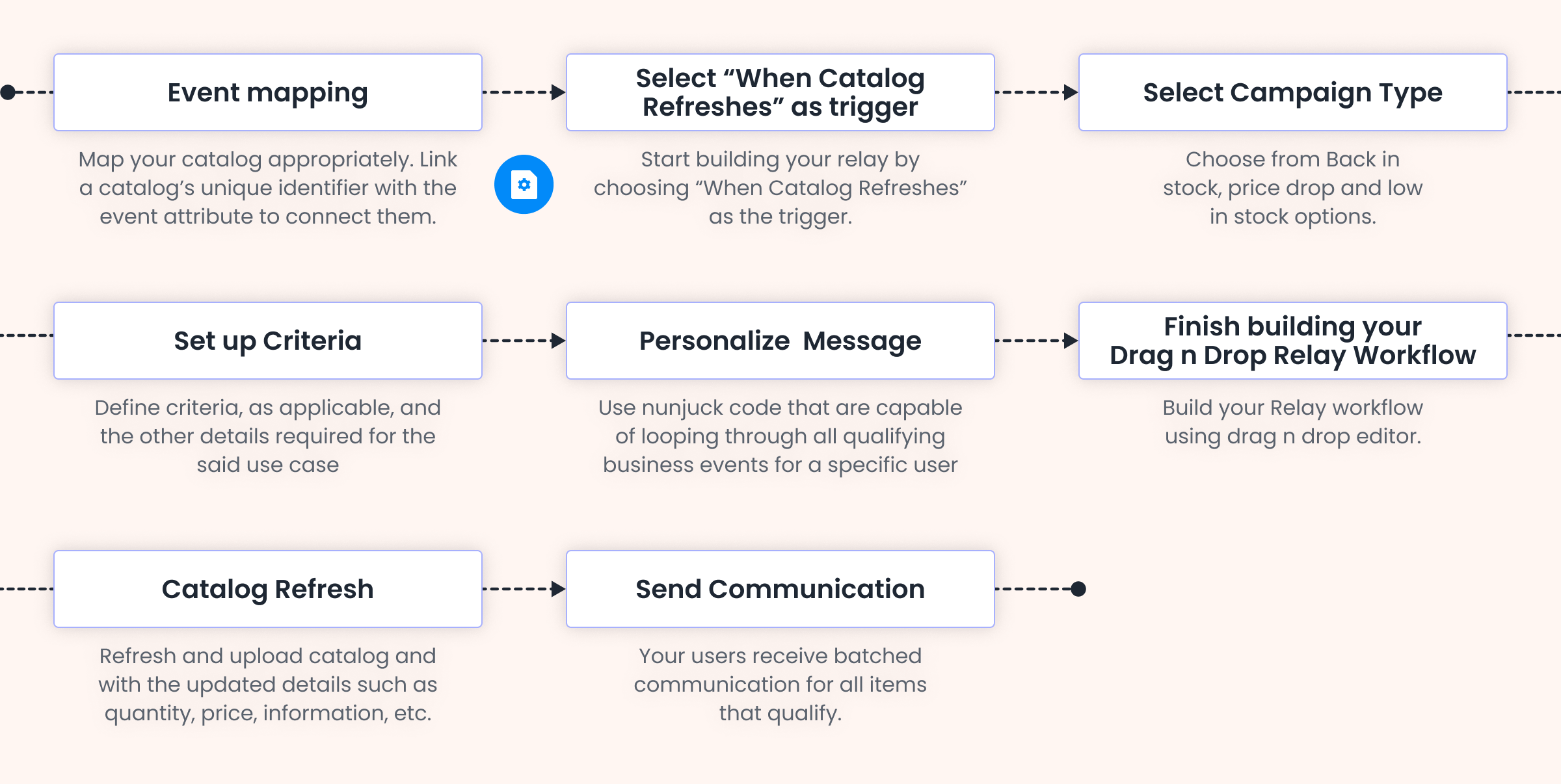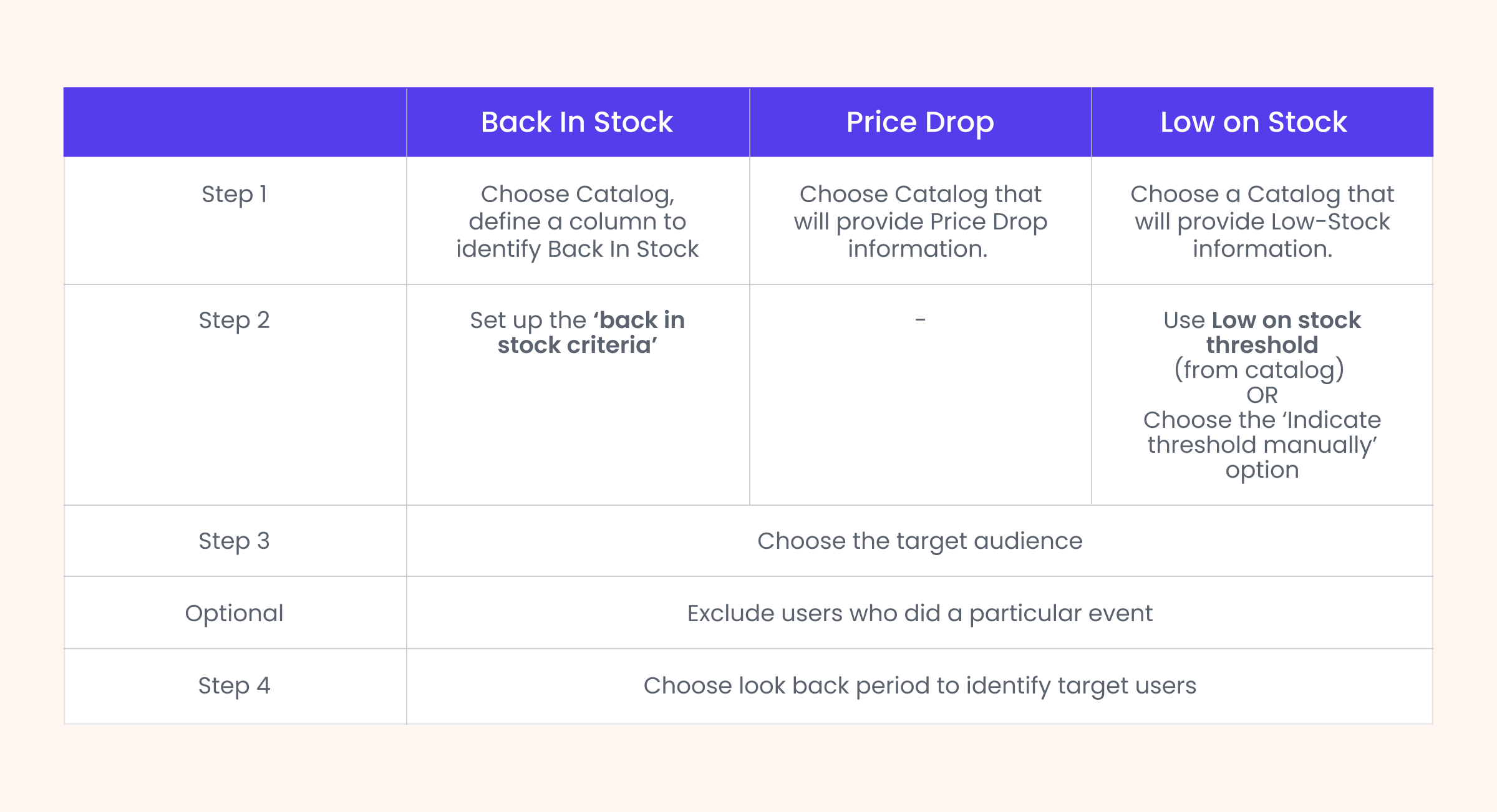Imagine the excitement your customers feel when they receive a notification that an item they’ve been eyeing is back in stock or when a price drop occurs. Now picture this: as a business, you can trigger these timely notifications as effortlessly as uploading a file with Catalog Relays. This seamless connection between your inventory updates and customer communication can significantly enhance engagement and boost satisfaction.
A Recap of Relays on WebEngage
- Introduced Relays – Automate Business Event-Triggered Campaigns
Relays were designed to automate communication workflows based on specific business events. Similar to Journeys, where communication flows are triggered by user actions, Relays allows you to initiate workflows based on business activities.

- Batched Relays – Streamlined Communication for Enhanced User Experience
The initial version of Relays was effective, but no user enjoys being bombarded with repetitive messages. To address this, we introduced Batched Relays, which group multiple business events and trigger communications at set intervals, resulting in a more cohesive user experience.

- Catalog Relays – Campaign Automation Through Catalog Integration
Our latest enhancement, Catalog Relays, enables seamless automation of campaign triggers by directly uploading events to your catalog. Whether it’s “Back in Stock,” “Low Stock,” or “Price Drop,” Catalog Relays ensure your campaigns are timely and highly targeted.
In this blog, we’ll explore how to leverage Catalog Relays for these common use cases.

When Will These Relays Be Triggered?
Each time your catalog is refreshed, it automatically assesses both users and catalog items to identify those that meet specific scenarios such as “Back in Stock,” “Low Stock,” or “Price Drop.” These triggers function as Batched Relays, allowing users to qualify for multiple items at once. This approach ensures your communications are timely, relevant, and perfectly aligned with what your users are seeking, right when they need it.
Using Catalog Relays
- Keeping Your Master Key Updated
Your catalog acts as the master key for triggering these Relays. To leverage Catalog-Based Relays effectively, it’s essential to keep your catalog mapping accurate and up-to-date.

- Creating the Relay Workflow
Once you have successfully mapped your catalog events, you can start creating the Relay workflow. Visit our knowledge base for a step-by-step guide.

On the Configuration page, you will find three options: Back in Stock, Price Drop, and Low on Stock. Let’s explore each scenario in detail, along with the required fields:

- Back In Stock
Imagine you’re managing an online store, and some of your best-selling items have recently gone out of stock, leaving interested customers unable to make a purchase. Now that those items are back in stock, you want to reach out to the users who previously showed interest but couldn’t complete their purchase due to the unavailability. Use a “Back In Stock” relay to re-engage potential buyers and drive conversions.

- Price Drop
As the manager of an online store, you’ve recently lowered prices on several popular products. To maximize sales, you aim to notify users who previously expressed interest in these items but did not complete their purchases. This targeted outreach can encourage customers to take advantage of the new, reduced prices and boost conversion rates.
- Low in Stock
Imagine you’re managing an e-commerce store with several products nearing low stock levels. To quickly move this inventory, you choose to specifically target users who have previously shown interest in these items. This focused approach is more likely to lead to purchases, as you’re reaching out to customers who have already expressed interest, rather than casting a wider, less focused net.

Note: When choosing the look-back period, remember that a user cannot re-enter the relay for the same number of days. For example, if the look-back period is 7 days, a user who enters the relay will not be able to re-enter for the next 7 days.
Use Cases
While Price Drop, Low on Stock, and Back in Stock are well known use cases in the D2C and e-commerce industries, Catalog Relays can be adaptedfor various scenarios:
- Price Drops for Online Courses
Scenario: The price of an online course has dropped due to a special promotion.
Solution: Update your course catalog with the new, lower prices. Then, send personalized notifications to users who have previously shown interest in these courses, letting them know about the price drop.
- Course Enrollment – Low Stock Alert
Scenario: A popular course is filling up quickly, and only a few spots remain.
Solution: Update your catalog with the number of available spots. Send targeted alerts to users who have shown interest in this course or similar ones, notifying them that there are only a few spots left.
- Movie or Show Tickets – Limited Availability
Scenario: Tickets for an upcoming movie or show are nearly sold out.
Solution: Update your catalog with the current number of available tickets. Set a threshold for “low” availability. Personalized reminders with purchase links will be sent to users interested in this event when the number of available tickets falls below that threshold.
Wrapping Up
Catalog Relays is a powerful tool that automates and personalizes your communication efforts, ensuring customers receive timely notifications for key use cases. By integrating directly with your catalog, these Relays simplify the delivery of relevant, targeted messages, enhancing customer satisfaction and engagement.
Looking ahead, the WebEngage Product team plans to introduce Custom Catalog Relays. This advanced feature will allow you to set a more tailored criteria, such as triggering notifications for specific catalog categories, products within certain price ranges, changes in upcoming event timings, and more.
Since Catalog Relays is an access-controlled feature, please contact your Account Manager to get it enabled for your account. For a detailed guide on how to set up and use Catalog Relays, visit our Knowledge Base.


































 Prakhya Nair
Prakhya Nair
 Dev Iyer
Dev Iyer
 Harshita Lal
Harshita Lal